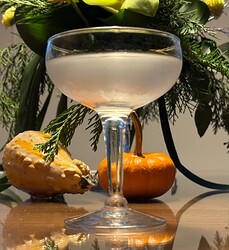Before it disappears into the bowels of the Interwebs, yesterday Barry Popik on Twitter shared an interesting column from the January 26, 1896 edition of the San Francisco Examiner.
The Gibson Cocktail
By the Author of “Chimmie Fadden.”Just at the minute that an “Examiner” reporter asked me to-day for a column to be printed on this page I couldn’t consider anything else than the matter I was discussing then. This matter was contained in a cocktail glass, and as my judgment is set with adamantine inflexibility against cocktails as they are generally known, I should be doing violence to my own feelings as well as to the feelings of your polite readers to mention the subject were it not that this cocktail is really not a cocktail at all. Do I seem to be speaking paradoxically? Then let me explain to you:
He happened to find me drinking a simple concoction which, on the little island of Manhattan, is known as the Gibson cocktail. Relinquishing my desire to speak only to your politest readers, I will, if you will permit me, discourse for a moment for the benefit and physical and mental and moral good of your less-polite readers who are addicted in any degree to the cocktail habit. To drink any cocktail is a sin which I have often taken opportunity to condemn; yet being a reasonable man and realizing the inevitableness of sin in some degree, I feel that he does wisely who minimizes any sin, hence I drink and talk about the Gibson cocktail. It is the invention of my friend, Mr. William Curtis Gibson, the managing editor of “Puck.” As we observe to be the case in all epoch-making inventions, its greatness lies in its simplicity. It is composed solely of one part gin and one part vermouth. Now that you have had it explained does it not seem that it should have been discovered long ago?
Yet it remained for my friend Gibson, after many, painstaking years of investigation, to discover that these ingredients compose the perfect cocktail. Will you try one? Is it not convincing?
• • •
By the way, the mention of Mr. Gibson recalls a very successful experiment in which he took a prominent part, and which will interest many San Franciscans. Mr. Gibson is a popular member of a set of clever men, illustrators and writers who for many years dined together at Martin’s restaurant on the corner of University place and Ninth street, New York, It was during my first year in New York that I had the good fortune to meet a number of the members of that set, and at that time they were discussing the formation of a dining club. They knew that I was a member of the Bohemian Club of San Francisco, and I attribute to that fact my good fortune in having been asked to join with them in founding what has since become a prosperous and popular club named the Cloister. Henry Bunner, the poet; Gibson, Jim Ford, the story-writer and satirist; Julian Ralph, and a score of such good men, founded the club and were heaven-inspired to introduce the feature of permitting members to bring ladies to the dinners.
I carefully instructed my fellow charter members in regard to the popular features of the Bohemian Club, and we soon had gathered together a hundred of the brightest chaps in the professions of writing and illustrating in New York. From Clinton place, where we first hung the crane, the Cloister has recently moved into a fashionable habitation on Forty-first street, and its assured success is an amiable contradiction of the dictum pronounced some years ago by the New York “Sun,” that the social conditions in New York made the formation of a Bohemian Club, such as that of San Francisco, impossible there.
(column continues)

